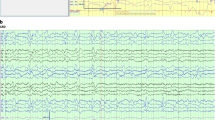Abstract
Background
Encephalitis lethargica (EL) is a CNS disorder that manifests with lethargy sleep cycle disturbances, extrapyramidal symptomatology, neuropsychiatric manifestations, ocular features and cardio-respiratory abnormalities. Although there have been no reported outbreaks of EL recently, a number of reports show that cases of EL are still encountered regularly. Against this background we conducted a study aiming to elucidate the clinical characteristics, describe laboratory/ neuroimaging findings (MRI, PET) and present treatment options and outcomes in sporadic EL.
Methods
Patients were diagnosed over a period of 3 years using proposed diagnostic criteria. Extensive laboratory and imaging tests were performed for exclusion of other causes. Anti-neuronal antibodies against human basal ganglia were detected with western immunoblotting and 18F-FDG PET imaging was performed. Selected cases were videotaped.
Results
Our patients (M/F: 5/3) ranged from 2–28 years (mean 9.3 ± 9.5). Encephalopathy, sleep disturbances and extrapyramidal symptoms were present in all cases. Laboratory investigations revealed CSF leukocytosis in 5/8 patients and anti-BG Ab in 4/7 patients. MRIs revealed structural abnormalities in 7/8 cases. 18F-FDG PET showed basal ganglionic hypermetabolism in 4/7 patients. Treatment approaches included immunomodulating and symptomatic therapies. We report no mortality from EL in our series.
Conclusions
There seems to be little doubt that cases of EL still occur. Diagnosis may be based on clinical suspicion and laboratory/imaging tests may lead to early initiation of immunomodulating and supporting therapies. We suggest that in addition to anti-BG Abs FDG PET should be considered as a diagnostic tool for EL.
Similar content being viewed by others
References
Anonymous (1966) Encephalitis oflethargica type in a mental hospital.Lancet 2:1014–1015
Blackman JA, Patrick PD, Buck ML,Rust RS Jr (2004) Paroxysmal autonomicinstability with dystonia afterbrain injury. Arch Neurol 61:321–328
Blunt SB, Lane RJ, Turjanski N, PerkinGD (1997) Clinical features and managementof two cases of encephalitislethargica. Mov Disord 12:354–359
Brenneis C, Scherfler C, Engelhardt K,Helbok R, Brossner G, Beer R, LacknerP, Walder G, Pfausler B, Schmutzhard E(2007) Encephalitis lethargica followingBartonella henselae infection.J Neurol 254:546–547
Caparros-Lefebvre D, Cabaret M,Godefroy O, Steinling M, Remy P,Samson Y, Petit H (1998) PET studyand neuropsychological assessment ofa long-lasting post-encephalitic parkinsonism.J Neural Transm 105:489–495
Church AJ, Cardoso F, Dale RC, Lees AJ,Thompson EJ, Giovannoni G (2002)Anti-basal ganglia antibodies in acuteand persistent Sydenham’s chorea.Neurology 59:227–231
Crookshank F (1919) Epidemicencephalomyelitis and influenza.Lancet i:79–80
Dale RC, Church AJ, Surtees RA, LeesAJ, Adcock JE, Harding B, Neville BG,Giovannoni G (2004) Encephalitislethargica syndrome: 20 new cases andevidence of basal ganglia autoimmunity.Brain 127:21–33
Dewar BK, Wilson BA (2005) Cognitiverecovery from Encephalitis Lethargica.Brain Inj 19:1285–1291
Dolan JD, Kamil R (1992) Atypicalaffective disorder with episodic dyscontrol:a case of von Economo’s disease(encephalitis lethargica). Can JPsychiatry 37:140–142
Ghaemi M, Rudolf J, Schmulling S,Bamborschke S, Heiss WD (2000)FDG- and Dopa-PET in postencephaliticparkinsonism. J Neural Transm107:1289–1295
Goldman S, Amrom D, Szliwowski HB,Detemmerman D, Goldman S, BidautLM, Stanus E, Luxen A (1993) Reversiblestriatal hypermetabolism in a caseof Sydenham’s chorea. Mov Disord8:355–358
Howard RS, Lees AJ (1987) Encephalitislethargica. A report of four recentcases. Brain 110(Pt 1):19–33
Kapadia F, Grant IS (1990) Encephalitislethargica. Intensive Care Med 16:338–339
Kenney C, Jankovic J (2006) Tetrabenazinein the treatment of hyperkineticmovement disorders. Expertreview of neurotherapeutics 6:7–17
Kiessling LS, Marcotte AC, Culpepper L(1993) Antineuronal antibodies inmovement disorders. Pediatrics 92:39–43
Kiley M, Esiri MM (2001) A contemporarycase of encephalitis lethargica.Clin Neuropathol 20:2–7
Kun LN, Yian SY, Haur LS, Tjia H(1999) Bilateral substantia nigrachanges on MRI in a patient withencephalitis lethargica. Neurology53:1860–1862
Lo KC, Geddes JF, Daniels RS, OxfordJS (2003) Lack of detection of influenzagenes in archived formalin-fixed,paraffin wax-embedded brain samplesof encephalitis lethargica patientsfrom 1916 to 1920. Virchows Arch442:591–596
McAuley J, Shahmanesh M, Swash M(1999) Dopaminergic therapy in acuteencephalitis lethargica. Eur J Neurol6:235–237
McCall S, Henry JM, Reid AH, TaubenbergerJK (2001) Influenza RNA notdetected in archival brain tissues fromacute encephalitis lethargica cases orin postencephalitic Parkinson cases.J Neuropathol Exp Neurol 60:696–704
Ono Y, Manabe Y, Hamakawa Y, OmoriN, Abe K (2007) Steroid-responsiveencephalitis lethargica syndrome withmalignant catatonia. Intern Med 46:307–310
Picard F, de Saint-Martin A, Salmon E,Hirsch E, Marescaux C (1996) Postencephaliticstereotyped involuntarymovements responsive to L-Dopa. MovDisord 11:567–570
Pruskauer-Apostol B, Popescu-PretorR, Plaiasu D, Tataru E, Ciobanu I,Voiculescu V (1977) The present statusof encephalitis lethargica. NeurolPsychiatr (Bucur) 15:125–128
Raghav S, Seneviratne J, McKelvie PA,Chapman C, Talman PS, Kempster PA(2006) Sporadic encephalitis lethargica.J Clin Neurosci 14:696–700
Rail D, Scholtz C, Swash M (1981) PostencephaliticParkinsonism: currentexperience. J Neurol Neurosurg Psychiatry44:670–676
Reid AH, McCall S, Henry JM, TaubenbergerJK (2001) Experimenting on thepast: the enigma of von Economo’sencephalitis lethargica. J NeuropatholExp Neurol 60:663–670
Shill HA, Stacy MA (2000) Malignantcatatonia secondary to sporadicencephalitis lethargica. J NeurolNeurosurg Psychiatry 69:402–403
Sridam N, Phanthumchinda K (2006)Encephalitis lethargica like illness:case report and literature review. J MedAssoc Thai 89:1521–1527
Tenembaum S, Chitnis T, Ness J, HahnJS (2007) Acute disseminated encephalomyelitis.Neurology 68:S23–S36
Verschueren H, Crols R (2001) Bilateralsubstantia nigra lesions on magneticresonance imaging in a patient withencephalitis lethargica. J NeurolNeurosurg Psychiatry 71:275
Vilensky JA, Foley P, Gilman S (2007)Children and encephalitis lethargica:a historical review. Pediatr Neurol37:79–84
Vilensky JA, Goetz CG, Gilman S(2006) Movement disorders associatedwith encephalitis lethargica: a videocompilation. Mov Disord 21:1–8
Vincent A (2004) Encephalitis lethargica:part of a spectrum of post-streptococcalautoimmune diseases? Brain127:2–3
von Economo C (1919) A case ofchronic encephalitis lethargica withintermittent course. Remarks regardingflu encephalitis. Münchenermedizinische Wochenschrift 66:1311–1313
von Economo C (1917) Encephalitislethargica. Wiener Klinische Wochenschrift30:581–585
Von Economo C (1917) New contributionsto Encephalitis Lethargica.Neurol Centralblatt 63:866–878
Wolf G (1953) Sporadic incidence ofencephalitis lethargica (von Economo).Dtsch Med Wochenschr 78:968–970
Author information
Authors and Affiliations
Corresponding author
Electronic Supplementary Material
Rights and permissions
About this article
Cite this article
Lopez-Alberola, R., Georgiou, M., Sfakianakis, G.N. et al. Contemporary Encephalitis Lethargica: Phenotype, laboratory findings and treatment outcomes. J Neurol 256, 396–404 (2009). https://doi.org/10.1007/s00415-009-0074-4
Received:
Revised:
Accepted:
Published:
Issue Date:
DOI: https://doi.org/10.1007/s00415-009-0074-4




